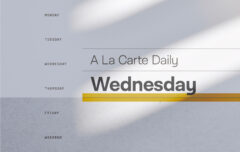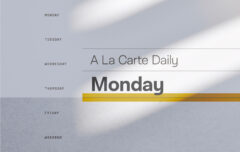Home. I love home. I love my home and I love the very idea, the concept, of home. God is good to give us home, to give us a place where we can just be, a place where we can center our lives. Think about your home, think about how good it is to have a place of your own, a place where you have your stuff and your people and where you live your life, and you’ll realize what a calling it was for Christ to have no home, to have no place to call his own.
We look at home today, we look at private life, and tend to assume that things have always been as they are now. And yet this is not the case. The home and the private life have developed over time, slowly evolving into what they are today and slowly evolving toward what they will be tomorrow. Home and private life are the twin subjects of Bill Bryson’s new book: At Home: A Short History Of Private Life.
Bryson recently purchased an old Norfolk Church of England rectory as his home and it provides the starting point for his investigations. “Looking around my house, I was startled and somewhat appalled to realize how little I knew about the domestic world around me. Sitting at the kitchen table one afternoon, playing idly with the salt and pepper shakers, it occurred to me that I had absolutely no idea why, out of all the spices in the world, we have such an abiding attachment to these two. Why not pepper and cardamom, or salt and cinnamon? And why do forks have four tines and not three or five?” Those mundane observations and the questions they generated got him started in his quest to understand home. And somehow he makes home, the most mundane place in our lives, utterly fascinating.
“If you had to summarize it in a sentence, you could say that the history of private life is a history of getting comfortable slowly.” Do you enjoy your home and all its comforts? That’s because we humans have been working tirelessly for all these millennia to make home a place of comfort. Slowly, slowly we have gotten to the point we are at today.
To add structure to the book, Bryson walks through his home, room by room, and allows each room to be the subject of a chapter. Along the way Bryson offers all kinds of fantastic wanderings, meanderings and observations so that each room really is only a starting place. I am sure there are some who get frustrated by all of the author’s wanderings. You’ll have to learn to embrace them because they really are the point of the book. Embrace them, and you’ll come to love them.
Consider this, something he observes while investigating the history of the bedroom.
Your bed alone, if it is averagely clean, averagely old, averagely dimensioned, and turned averagely often (which is to say almost never) is likely to be home to some two million tiny bed mites, too small to be seen with the naked eye but unquestionably there. It has been calculated that if your pillow is six years old (which is the average age for a pillow), one-tenth of its weight will be made up of sloughed skin, living and dead mites, and mite dung—or frass, as it is known to entomologists.
Or how about stairs? Ever paused to think about stairs–how they came to be, and what kind of effect they have on us?
Everybody trips on stairs at some time or other. It has been calculated that you are likely to miss a step once in every 2,222 occasions you use stairs, suffer a minor accident once in every 63,000 uses, suffer a painful accident once in every 734,000, and need hospital attention once every 3,616,667 uses.
He often traces the history of words that we use all the time but think about seldom. Like toilet. Why on earth is toilet water something you daub on your face and something swirling around the bowl and carrying away your waste?
Perhaps no other word in English has undergone more transformations in its lifetime than toilet. Originally, in about 1540, it was a kind of cloth, a diminutive form of toile, a word still used to describe a type of linen. Then it became a cloth for use on dressing tables. Then it became the items on the dressing table (whence toiletries). Then it became the dressing table itself, then the act of dressing, then the act of receiving visitors while dressing, then the dressing room itself, then any kind of private room near a bedroom, then a room used lavatorially, and finally the lavatory itself. Which explains why toilet water in English can describe something you would gladly daub on your face or, simultaneously and more basically, water in a toilet.
He often relies on a subtle sense of humor that often got me laughing out loud. Like here, as he discusses wine:
But it is thanks to American roots that French wines still exist. It is impossible to say whether wines are worse now than they were before. Most authorities think not, but such a desperate remedy is bound to nurture lingering doubts among those who are inclined to have them. What is certainly true is that surviving pre-phylloxera wines have attracted a cachet that has led people to part with a good deal of their money and much of their common sense in a quest to possess something so deliciously irreplaceable. In 1985, Malcolm Forbes, the American publisher, paid $156,450 for a bottle of Château Lafite 1787. This made it much too valuable to drink, so he put it on display in a special glass case. Unfortunately, the spotlights that artfully lit the precious bottle caused the ancient cork to shrink and it fell with a $156,450 splash into the bottle. Even worse was the fate of an eighteenth-century Château Margaux reputed to have once been owned by Thomas Jefferson and valued, very precisely, at $519,750. While showing off his acquisition at a New York restaurant in 1989, William Sokolin, a wine merchant, accidentally knocked the bottle against the side of a serving cart and it broke, in an instant converting the world’s most expensive bottle of wine into the world’s most expensive carpet stain. The restaurant manager dipped a finger in the wine and declared that it was no longer drinkable anyway.
Or like here, when he discusses hygiene (and seriously, be grateful that we live in an age of good hygiene)!
As people adjusted to the idea that they might safely get wet from time to time, long-standing theories about personal hygiene were abruptly reversed. Now instead of it being bad to have pink skin and open pores, the belief took hold that the skin was in fact a marvelous ventilator—that carbon dioxide and other toxic inhalations were expelled through the skin, and that if pores were blocked by dust and other ancient accretions natural toxins would become trapped within and would dangerously accumulate. That’s why dirty people—the Great Unwashed of Thackeray—were so often sick. Their clogged pores were killing them. In one graphic demonstration, a doctor showed how a horse, painted all over in tar, grew swiftly enfeebled and piteously expired. (In fact, the problem for the horse wasn’t respiration but temperature regulation, though the point was, from the horse’s perspective, obviously academic.)
I could go on and on. This book may not change your life, but I am sure you’ll find yourself enjoying it a lot–and hopefully as much as I did. It isn’t quite light reading, but it also isn’t at all heavy. It’s just the kind of book you’ll love to read while sitting through a long flight or while crashing on the couch on a Saturday afternoon.
Really my only complaints with the book are these: Bryson uses the word agreeable a few too many times and he writes (not surprisingly) from the perspective of one who holds to evolution, something that comes through every now and again. Beyond that, it’s just a good, fun, enjoyable, informative read. Buy it for yourself or get it for a gift. You’ll love it.










